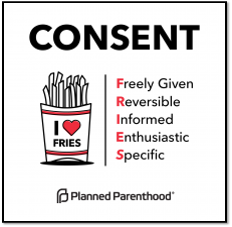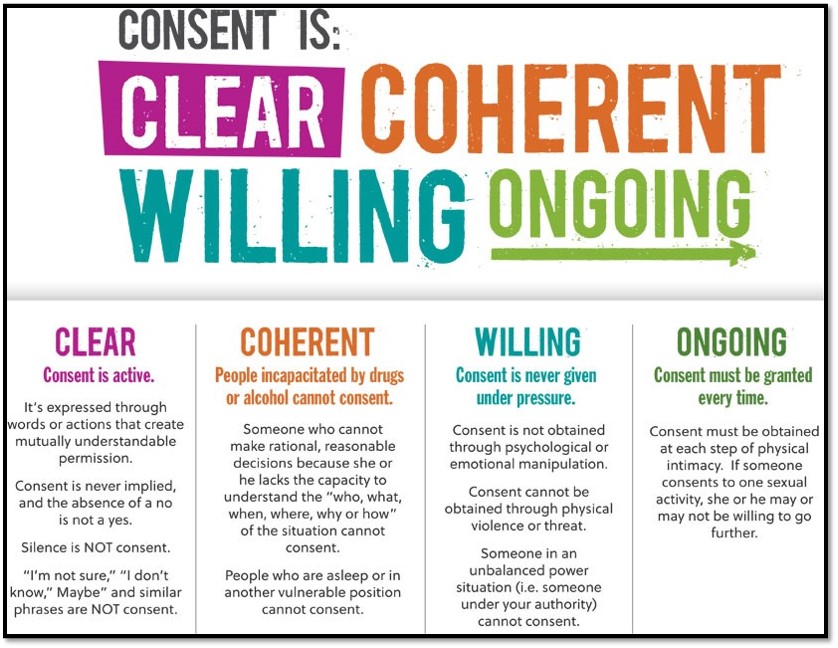Student Health Services at Moffitt Health Center
Healthy Relationships and Bystander Intervention
Page Content
College is a great time to build new relationships. Knowing how to communicate effectively is key to building healthy and stable relationships. Focus on attributes of what makes your relationships happy and healthy. Practice healthy boundaries, understand consent, and know when and how to step in as a bystander to protect your friends. Incorporating these skills and following the tips found below will help you develop healthy relationships that will ultimately enrich your college experience.
What is a Healthy Relationship?
Speak Up. In a healthy relationship, if something is bothering you, it's best to talk about it instead of holding it in.
Respect Each Other. Your partner's wishes and feelings have value, and so do yours.
Compromise. Disagreements are a natural part of healthy relationships, but it's important that you find a way to compromise if you disagree on something. Try to solve conflicts in a fair and rational way.
Be Supportive. Offer reassurance and encouragement to each other. Also, let your partner know when you need his or her support.
Respect Each Other's Privacy. Just because you're in a relationship doesn't mean you have to share everything and constantly be together. Healthy relationships require space.
Healthy Boundaries. By setting boundaries together, you both can have a deeper understanding of the type of relationship that you and your partner want. Creating boundaries is not a sign of secrecy or distrust - it's an expression of what makes you feel comfortable and what you would like or not like to happen within the relationship.
What isn't a Healthy Relationship?
Relationships that are not healthy are based on power and control, not equality and respect. In the early stages of an abusive relationship, you may not think the unhealthy behaviors are a big deal. However, possessiveness, insults, jealous accusations, yelling, humiliation, pulling hair, pushing or other abusive behaviors are - at their root - exertions of power and control. Remember that abuse is always a choice, and you deserve to be respected. There is no excuse for abuse of any kind.
Ten Tips for Healthy Relationships
- Keep expectations realistic
- Talk with each other
- Be flexible
- Pay attention to you too
- Be dependable
- Fight Fair
- Smile and show your interest
- Keep your life balanced
- Sometimes it takes time
- Be you!
Adapted from Ten Tips for Healthy Relationships by Joyce Woodford
Additional Resources:
Open and honest communication is key to any healthy relationship. Use the links below to find out more information on how to communicate better, set boundaries, and resolve conflict within your relationships.
Setting Boundaries - National Domestic Violence Hotline
Dating violence and domestic violence can happen to anyone. Abuse can sometimes be hard to identify as behaviors move from healthy to unhealthy. Knowing what early warning signs to look for can help you determine when a relationship is headed in the wrong direction. Abuse is about power and control and is never OK. Use the links below to learn more about what abuse is, how to identify it, and what you can do to get help.
Is this abuse? - LoveIsRespect.org
Is this abuse? - National Domestic Violence Hotline
Consent is communicating every step of the way, respecting that when they don’t say “no,” it doesn’t mean “yes," and breaking away from gender “rules" associated with intimacy.

Consent is a mutual agreement between partners about what they want to experience.
Consent should happen EVERY TIME.
Relationship status doesn't make consent automatic.
An incapacitated person cannot give consent.
Non-consent means STOP.

Additional Resources:
Consent - National Domestic Violence Hotline
A bystander is an observer of a situation or a potential situation in which a friend or stranger may experience hurtful or harmful acts.
A bystander can be active, intervening in these situations, or passive, choosing not to intervene. Everyone is a potential bystander.
As a bystander, you have the opportunity to:
- Speak out against statements, attitudes, or behavior that foster a culture of violence, sexual assault, or harm to others
- Identity and stop situations that could lead to a sexual assault
- Step-in during a high-risk incident
- Support and believe others when they are impacted by a harmful act
- Help others respond to unfavorable and problematic situations
Choosing to be an active bystander means you:
- Are ready, both mentally and physically, to intervene.
- Have identified the problematic behavior.
- Can appeal to principles and be empathetic of the person's experience. Believe most people are good people.
- Can set a limit to how you respond, especially if your safety is at risk.
- Have allies or can find allies to assist you in intervening.
Bystanders should be honest and direct, try to intervene before a situation escalates to a crisis, avoid the use of violence as a means for intervention, and know when to ask for help from others and/or professionals if needed. Visit the links below for more information on how you can become an active bystander and make a difference in your community.
Intervening - Knowing When and How to Respond (Distract, Direct, Delegate)
Shafer Center for Crisis Intervention - Green Dot Bystander Intervention Training